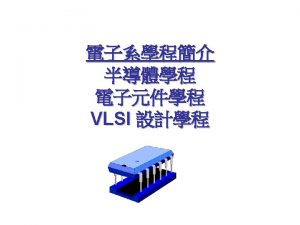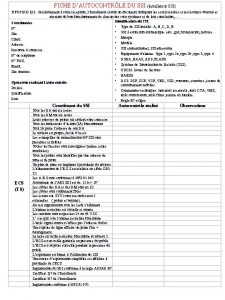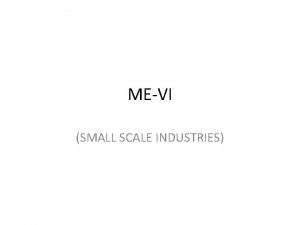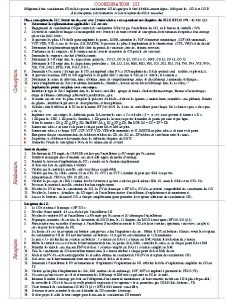Small Scale Industries in India MEANING OF SSI



























- Slides: 27

Small Scale Industries in India

MEANING OF SSI • Small industries include all those units having a fixed capital above Rs. 25 lakh and upto Rs. 5 crore invested in plant and machinery and service enterprises having investment above Rs. 10 lakh and upto Rs. 2 crore in equipment's. • Hired- laborers are employment in small-scale industries. • Machines and power are used for example Hosiery industry in Ludhiana, scientific instruments industry in Ambala, carpet manufacturing industry in Panipat, Radio and TV manufacturing units in Delhi are the example of smallscale industries. COTTAGE INDUSTRIES Cottage Industries are mainly rural in character and are generally associated with agriculture involving operations mostly by hands and are carried on inthe home either as a whole time or as a part time occupation, primarily withthe help of members of the family. • •

OBJECTIVES OF SSI • • • Creation of employment opportunity. Improvement of output , income and better standard of living. Elimination of economic backwardness of rural and underdeveloped areas. To reduce regional imbalance. To provide employment and means of a regular source of income to the needy people living in rural and semi-urban areas. To improve the quality of industrial products produced in cottage industries and increase production and profits. To facilitate import substitution. To encourage entrepreneurship and self-reliance. To mobilize regional resources of capital.

Difference Between Cottage and Small Scale Industries. Cottage industries Small scale industries Location Are mostly in villages Are mostly in urban areas Labourers Do not have hired labourers There are hired labourers capital Very little capital is capital worth Rs. 5 crore invested in these industries invested in plant and machinery. Goods produced In these industries traditional goods like Khadi, mattress, shoes are produced. Many modern goods like radio, television etc are produced in these industries.

Role and Importance of SSIs • Small scale unit carry on business on a small scale and as such the element of risk is less. • Small Scale units are generally based on local resources and as such there is no problem regarding their availability. • Small scale unit can be located anywhere and thus help in the development of backward areas of the country. • Possibility of earning and saving foreign exchange by exporting goods produced from local resources used by SSI in the production. • SSIs don’t require to a high level of technology. • SSIs generate immediate employment opportunities , these are 7 times more employment oriented than large-scale industries. These industries are mainly based on labour intensive techniques and generate more employment opportunities. • In these industries capital is not concentrated in a few hands. Hence these are instrumental in the equal distribution of income and wealth. • These industries produce artistic goods, such as Banarsi Sarees, Ivory work, Carpets, Ornaments etc.

• Decentralization- Large scale industries have mostly the tendency to concentrate at one place. It leads to regional imbalance. During war these industries are likely to affect more on the contrary small scale industries are dispersed throughout the country. • Less pressure of population on agriculture- if small scale and cottage industries are established in large numbers and more villages are employed in them it would reduce the pressure of population in agriculture. • Increase in production- there is possibility of increase in production, 55% is from large scale industries and 45% is from small scale industries. • Need less capital- these are labour intensive industries so they require less capital with a investment of 4 to 5 lakh micro enterprises can be started.

• Encouragement to cooperation- small scale and cottage industries can be started with little capital. . They can also be easily organised on the basis of cooperation. Every common man can join hand set up small scale industries on the basis of cooperation. • Role in export- These industries have great importance in the export trade of industries of the country. SSI sector dominates in export of sport goods, readymade garments, plastic products, leather products, handicrafts processed food etc. In 2014 -15, contribution of small and micro enterprise was 40% of total exports. • Short gestation period- the period between setting up of an industry and its actual production is called gestation period. The project related to SSIs can be completed in short period and hence become productive in a Short Gestation Period. • .

Disadvantage and Problems Faced By SSIs • • • High cost of production Wastage of by-products Less use of Machines Lack of Division of Labour Difficulty in getting Loans Competition with large scale industries. Costly Raw Materials Lack of Standardised Goods Old Techniques Lack of Research Difficulties in Marketing.

Problems faced by cottage and small scale industries ØProblem of Raw Material: • These industries do not get raw material in adequate quantity. whatever raw material they get is poor in quality and high in price. It increases the cost of production and the goods produced are of inferior quality. ØLack of power: • These industries do not get regular power supply. There are frequent power-cuts. Small industries do not have alternative source of energy , so their production process suffers on account of shortage of power.

Problem of Finance: • These industries do not get adequate loan facilities , as they cannot offer good security because of poverty. They get very little financial accomodation from commercial banks and industrial co-operative societies. So they largely depend on private moneylenders for finance the latter change exorbitant rate of interest in some cases compel the debtors to sell their finished products to them at cheap price. In this way, these industries are subjected to double exploitation. • Old Methods of Production: • These industries make use of old machines of production mostly. Old tools and equipments , like oil expellers and handlooms, are still in use. The result is fall in quantity of output and the goods produced are of inferior quality. Such goods have very little demand.

Problems of marketing • • • These industries have to face a lot of difficulties in selling their goods at fair prices and in sufficient quantity. For eg. Because of high cost of production, price of the finished product increases very high. Outward appearance of the product is not so appealing, the goods also lack in uniformity. Tastes of the people are also undergoing change, like earthen pottery is being replaced by aluminium and steel utensils. People like goods with ever changing designs. These industries fail to produce such goods. These industries have no sales-promotion organisation of their own. They have to depend upon middlemen and brokers. Due to lack of funds, these industries, cannot afford to bear advertisement and promotion costs. So their goods are not so popular.

High cost of production: Cost of production is high in these industries. It is due to high cost of raw material, old methods of production, unskilled labour and high per unit fixed costs because of small quantity of production. Competition with Large-scale industries: One of the main problems of these industries is that they have to face competition with large-scale industries. Finished products of large-scale industries are relatively cheap and are of good quality. So they cannot compete with large-scale industries.

More importance to Artistic Goods: • Cottage industries of India have so far, concentrated their attention on the production of artistic goods. Demand of these goods is limited, so these industries cannot increase their production. ØLack of Able Entrepreneurs: These industries face shortage of competent entrepreneurs to run them. Workers are mostly illiterate, ignorant and orthodox. Due to lack of education, they are ignorant of new equipments and modern techniques of production. They are therefore unable to organise their industries efficiently.

Govt. Steps for the Development of the SSIs (1) Many organizations and boards have been established to develop these industries like: • Cottage Industries Board • Handicraft Board • Handloom Board • Khadi & Village Industries Board, many organisations and boards have been established to develop these industries, now this organisations is known as micro, small and medium enterprises development organisations. the objective of these organisations is to offer help to develop micro, small and medium industries. In 1955, national small industries corporation was set up. Its function were to provide marketing facilities to micro and small industries, to get them machines on instalment basis and to offer advice on various problems of small industries. (2) To provide financial help to Small & Cottage industries several measures were taken like • Cooperative & Commercial Banks • State finance Corporations • State Industrial Development Corporations • Small Industries Development Bank of India • Reserve bank of india. Govt. has directed all public sector banks to open at least one branch for financing SSI in each district. Reserve bank of india launched credit guarantee scheme IN ORDER TO GUARANTEE THE LOANS GIVEN TO SMALL INDUSTRIES.

(3) Central Cottage Industries Emporium has been founded to market the goods produced by these industries. National Small Industries Corporation also arranges for the sale of goods of these industries. special attempts are being made to market the goods produced by these industries. CENTRAL COTTAGE INDUSTRIES EMPORIUM HAS BEEN FOUNDED FOR THE PURPOSE. (4) With a view to imparting training to entrepreneurs engaged in MSME following institutes have been set up by MSME Development Organisation • 30 MSME Development Institutes • 28 Branch Institute • 4 Regional Testing Centres • 7 Field Testing Stations • 6 Technology Development Centres etc. (5) Govt. is also a big customer of goods produced by small industries. Govt. has directed all Ministries/ departments/PSUs to purchase at least 20% of their total purchase from MSME. government is also a big customer of goods produced by small industries. Govt. buys 358 items produced exclusively by small industries.

Common production programme: - it was recommended in the first five year plan that a common production programme be chalked out of reduce competition between large-scale and small industries. Technical assistance: - with a view to imparting techincal training to entrepreneurs engaged in micro, small and medium enterprises, 30 msme development instiutes etc have been set up Micro, small and medium enterprises development organisation.

Improved tools: - improved tools are made available to small industries on hire purchase system. Industries co-operative societies: - in order to supply raw material and provide cheap credit to small industries and to market their products. Presently there about 55 thousand industrial cooperative societies. Their apex body called national federation of industrial cooperatives has also been formed. Export incentives: - special efforts are made by the govt. To encourage exports of the goods produced by small industries. state trading corporation also gives advice regarding export trade to small imdustries.

Industrial estates and special economic zones(sezs): - govt. Has set up industrial estates and special economic zones to develop these industries. Govt. Acquries land develops it from industries point of view. Differential taxation: - govt. Has levied many taxes on large scale industries and exempted fully or partially small and cottage industries from the payment of taxes. Availability of raw material: - these industries have been given facilities to import new material from abroad. Trading corporations like state trading corporation. District industries centre: - functions of these centres are to supply machines, to arrange raw material, to arrange for loans, to determine quality level etc. Setting up mahatma gandhi institute for rural industrialisation: - govt. Has set up this institute to imptove research and development activities, to upgrade technological level among MICRO and small enterprises in rural areas.

Small-scale industries and five year plans • Development of small scale industries has been given a special place in the five year plans. Common production programme was launched for the purpose of developing these industries. An outlay of 43 crore was made for the development of tgese industries. In third, fourth, fifth and sixth plans, tge amount spent on tgese industries was 241 crore, 243 crore, 592 crore and 1945 crore respectively. In the seventh plan, an amount of 3249 crore was spent on the development of these industries. During eighth year plan 7094 crore was spent on these industries. In ninth plan 8812 ctore was spent on small scale and cottage industries. During thenth year plan 7754 crore was spent on small- scale and cottage industries. In eleventh year plan 10430 were spent for developments of micro small and medium enterprises. In twelfth plan 26014 crore were spent for development of micro, small and medium enyerprises.

New Policy for Small Scale Industries New policy was announced on 6 th aug, 1991 and latest amendment was done in the year 2006. Main Features: (1) Defining MSME: In 2006 separate investment limits have been defined for manufacturing and service enterprises. (i) Manufacturing Enterprises- based on investment in plant and machinery (a) Micro Enterprises- Investment upto Rs 25 lakh. (b) Small Enterprises- Investment above Rs 25 lakh and upto Rs 5 Cr. (c) Medium Enterprises- Investment above Rs 5 Cr and upto Rs 10 Cr. (ii) Service Enterprises- based on investment in equipment. (a) Micro Enterprises- Investment upto Rs 10 lakh. (b) Small Enterprises- Investment above Rs 10 lakh and upto Rs 2 Cr. (c) Medium Enterprises- Investment above Rs 2 Cr and upto Rs 5 Cr.

(2) Meaning of Enterprise: Earlier enterprise meant by and large manufacturing enterprises but under new policy it includes both, manufacturing and service enterprises. Package for promotion of tiny enterprises: - a separate package for the promotion of tiny enterprises is introduced. Such enterprises are made eligible for various types of support on a continuning basis. Equity participation: - the new policy provides that the large units can purchase upto 24 percent shares of the total sgare holding of small units. Limited partnership: - one of the special features of the new policy is the intoduvtion of a new legal from of the business organisation, namely, restricted or limited partnership. (3) Technological Development: A technological development cell has been set up in the Small Industries Development Organizations (SIDO) which would provide technology inputs to improve productivity and competitiveness of small scale sector. (4) Marketing: National Small Industries Corporation (NSIC) helps small enterprises to participate international & national exhibitions/ trade fairs at the subsidized rates to exhibit & market their products. (5) Financial Support: Under new policy the loan limit has been raised to Rs 1 Cr for SSI. Interest rate concession of 2% has been announced for MSME

Simplification of rules: - the rules and procedures relating to small scale sector are simplified. Infrastructural facilities: - to facilitate location of industries in rural or backward areas and to promote stronger linkages between agriculture and industry. • Availability of raw material: - adequate and equitable distribution of indigenous and imported raw materials would be ensured to small- scale sector. • Export incentives: - an export development centre has been set up in sidco to encouage export activities of this sector. Training: - many new enterpreneurs have been trained under entrerpreneurtship development programmes. Industry associations are encourged to participate in this venture effectively. For providing trading and consultancy services to enterpreneurs engaged in msme sector. Factoring services: - a beginning has been made towards solving the problem of delayed payments to small imdustries by setting up factoring serivices through small industries development bank of india (sidbi). Factoring is continous arrangement between a financial instittion and business concern selling gooda and services to customers on credit.

Recent Incentives/Facilities for SSI • • In 2017 SSI with aggregate turnover of upto Rs 20 lakh in a year are exempted from GST. To Grant financial facilities for modernization a joint program has been launched by SBI & SIDBI. Integrated Infrastructural Development was launched to strengthen infrastructural facilities in rural & backward areas. Govt. has announced Public Procurement Policy in which all public sector units are to purchase at least 20% of their total purchase from MSMEs. MUDRA Bank Micro units development refinance agency bank(mudra bank) has been created to meet the re-finance requirement of micro finance institutions which are lending to MSME sector. It will help in easy availability of credit to msme. The Quality Certification Scheme is launched to improve the quality of the products of SSIs. Rajiv Gandhi Udyami Mitra Yojana has been launched to offer guidence and help in completing the formalities for establishment of MSMEs.

• Investment limit for small-scale industries has been raised from 1 crore to 5 crore • Along manufacturing enterprises service enterprises are also covered within the meaning of small scale industries. • Special economic zones are promoted by the govt. For promoting small and medium enterprises. • in 2007 -08, the sales eligibility limit for Excise duty exemption was raised to 1. 50 crore • Infrastructural support is given to entrepreneurship development institutes(EDIs) to increase their training capacities. Micro and small entrepreneurs are provided under Management development programme To develop skills.

• Small- scale units are sanctioned loans on priority basis. • A scheme of integrated infrastructural development was launched • The quality certificate scheme was launched to improve the quality of the products of small scale industries. • A scheme for creation of Technology development fund is launched by central govt. With the improvement of state govt. And industry associations. • SSI associations are encouraged to Develop and operate testing laboratories. Once the capital grant of 50 percent is given on reimbursement basis of such associations. • Credit guarantee fund (scheme) has been launched for ssi to provide guarantee for loans upto 1 crore extends by commercial banks, regional rural banks and other financial institutions

IMPACT OF LIBERALIZATION, PRIVATIZATION AND GLOBALIZATION ON SSIs • Liberalization, Privatization and globalization(LPG) Process started in India in July 1991 that had changed the face of industry. • Liberalization had made import of scarce and non-available raw materials easy. • This had led to many new openings. New entrepreneurs have started many SSIs which otherwise was not possible due to non-availability of certain raw materials and resources. Liberalization helped getting them from abroad and use them. The best example for effect of Liberalization is electronic and computer industries that have seen tremendous growth in past 2 decades. • Privatization also helped the growth of SSIs in a big way. • Indian entrepreneurs have used the globalization for the growth of service sectors. • Earlier certain products/services were produced only by Government organizations and no competition existed. • The spectacular growth is observed in Business Process Outsourcing (BPO), transport, repair services , entertainment, and hospitality sectors.

• With privatization, it threw open to many challenging entrepreneurs to produce similar goods and services at much competitive price and better quality. • �The important development due to privatization is life insurance sector which was earlier monopolized by LIC. Now there are many private agencies offering Life insurance , health insurance and others. • Globalization has helped in setting many small scale industries. It made possible the export of goods produced in SSI. • Industries and services providers are going global from Indian entrepreneurs in Pharma Sector , I. T Sector, Steel Sector have gone to many countries to start new ventures. • �� There has been a big growth of entrepreneurial activities in rural India in the areas like food processing , ready-to-eat and parked food, export of food products like fish , meat , prawns etc. , due to LPG.
 Small scale integration (ssi)
Small scale integration (ssi) Ultra large scale integrated circuits
Ultra large scale integrated circuits Importance of women entrepreneurship
Importance of women entrepreneurship Rationale of small scale industries
Rationale of small scale industries Bulk reducing industry examples
Bulk reducing industry examples Small vs large scale maps
Small vs large scale maps Types of statement scale
Types of statement scale Large scale map
Large scale map Large scale vs small scale map
Large scale vs small scale map Geography skills handbook
Geography skills handbook Pdc components
Pdc components Faridabad small industries association
Faridabad small industries association State small industries corporation (ssic)
State small industries corporation (ssic) Small kingdoms in north india are called
Small kingdoms in north india are called Ssi classification
Ssi classification What is ssi
What is ssi Ssi bundle
Ssi bundle What is ssi
What is ssi Sigmoidectomy
Sigmoidectomy Marcel riedel
Marcel riedel Ex collaboratori ssi
Ex collaboratori ssi Ssi msi lsi vlsi ulsi classification
Ssi msi lsi vlsi ulsi classification Modele fiche autocontrole ssi
Modele fiche autocontrole ssi Ssi vs ssdi
Ssi vs ssdi Supplemental security income (ssi)
Supplemental security income (ssi) Ssi shimadzu
Ssi shimadzu Ssdi vs ssi
Ssdi vs ssi Transducer techniques ssi
Transducer techniques ssi

















































